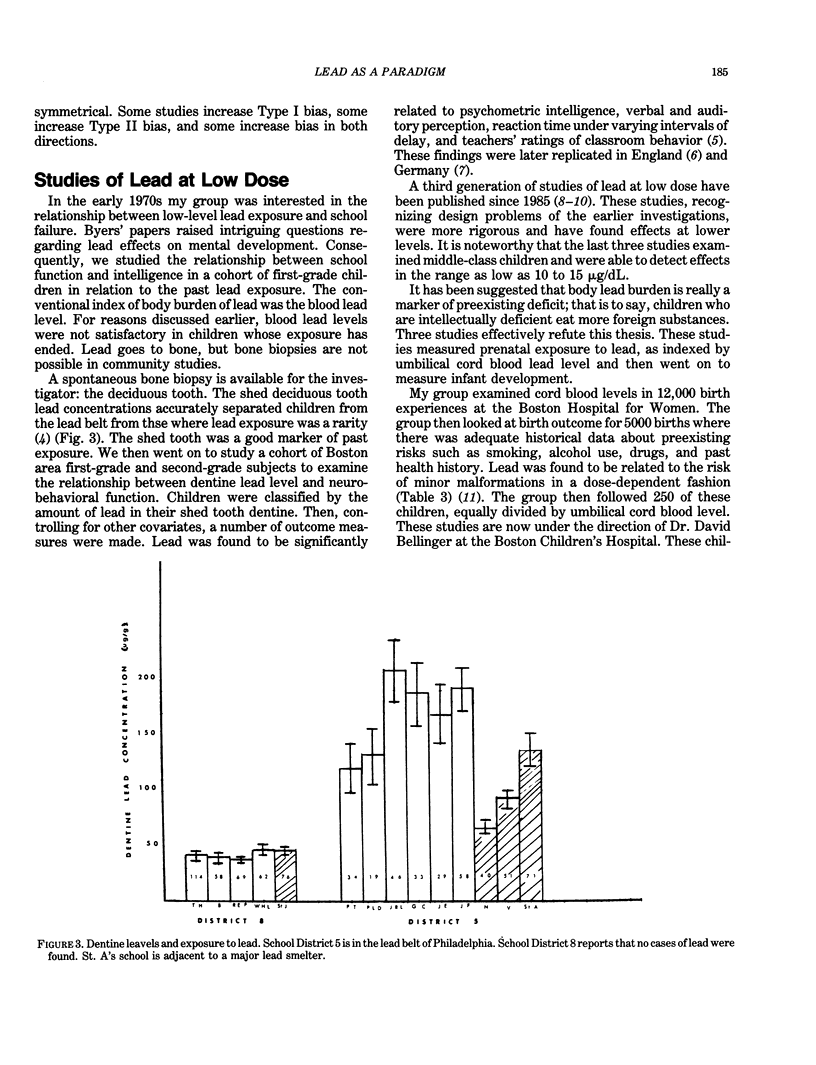Abstract
The history of knowledge about lead toxicity may serve as a useful template to judge and predict progress in understanding other toxicants. A paradigm shift has occurred in which toxicity has been recognized at levels long held to be harmless. This shift has been accelerated by the use of newer tools for measuring outcome. Lead effects have been identified in children at blood lead levels as low as 15 micrograms/dL. They include impaired psychometric intelligence, language function, attention, and classroom behavior. Lead exposure during pregnancy results in increased risk for minor malformations and lowered infant IQ scores until at least 2 years of age. Understanding of this toxicant has been blurred by seven unrecognized Type II errors frequently encountered in the lead literature. These errors are discussed. A meta-analysis of thirteen informative lead studies in children is presented. The joint probability of the findings occurring by chance under the null hypothesis is less than 3 x 10(-12).
Full text
PDF






Selected References
These references are in PubMed. This may not be the complete list of references from this article.
- Baghurst P. A., Robertson E. F., McMichael A. J., Vimpani G. V., Wigg N. R., Roberts R. R. The Port Pirie Cohort Study: lead effects on pregnancy outcome and early childhood development. Neurotoxicology. 1987 Fall;8(3):395–401. [PubMed] [Google Scholar]
- Barrett J., Livesey P. J. Lead induced alterations in maternal behavior and offspring development in the rat. Neurobehav Toxicol Teratol. 1983 Sep-Oct;5(5):557–563. [PubMed] [Google Scholar]
- Bellinger D., Leviton A., Waternaux C., Needleman H., Rabinowitz M. Longitudinal analyses of prenatal and postnatal lead exposure and early cognitive development. N Engl J Med. 1987 Apr 23;316(17):1037–1043. doi: 10.1056/NEJM198704233161701. [DOI] [PubMed] [Google Scholar]
- Cornfield J. Recent methodological contributions to clinical trials. Am J Epidemiol. 1976 Oct;104(4):408–421. doi: 10.1093/oxfordjournals.aje.a112313. [DOI] [PubMed] [Google Scholar]
- Ernhart C. B., Landa B., Schell N. B. Subclinical levels of lead and developmental deficit--a multivariate follow-up reassessment. Pediatrics. 1981 Jun;67(6):911–919. [PubMed] [Google Scholar]
- Harvey P. G., Hamlin M. W., Kumar R., Delves H. T. Blood lead, behaviour and intelligence test performance in preschool children. Sci Total Environ. 1984 Dec;40:45–60. doi: 10.1016/0048-9697(84)90341-3. [DOI] [PubMed] [Google Scholar]
- Milar C. R., Schroeder S. R., Mushak P., Dolcourt J. L., Grant L. D. Contributions of the caregiving environment to increased lead burden of children. Am J Ment Defic. 1980 Jan;84(4):339–344. [PubMed] [Google Scholar]
- Needleman H. L., Davidson I., Sewell E. M., Shapiro I. M. Subclinical lead exposure in philadelphia schoolchildren. Identification by dentine lead analysis. N Engl J Med. 1974 Jan 31;290(5):245–248. doi: 10.1056/NEJM197401312900504. [DOI] [PubMed] [Google Scholar]
- Needleman H. L., Gunnoe C., Leviton A., Reed R., Peresie H., Maher C., Barrett P. Deficits in psychologic and classroom performance of children with elevated dentine lead levels. N Engl J Med. 1979 Mar 29;300(13):689–695. doi: 10.1056/NEJM197903293001301. [DOI] [PubMed] [Google Scholar]
- Needleman H. L., Leviton A., Bellinger D. Lead-associated intellectual deficit. N Engl J Med. 1982 Feb 11;306(6):367–367. doi: 10.1056/NEJM198202113060618. [DOI] [PubMed] [Google Scholar]
- Smith M., Delves T., Lansdown R., Clayton B., Graham P. The effects of lead exposure on urban children: the Institute of Child Health/Southampton Study. Dev Med Child Neurol Suppl. 1983;47:1–54. [PubMed] [Google Scholar]
- Winneke G., Krämer U., Brockhaus A., Ewers U., Kujanek G., Lechner H., Janke W. Neuropsychological studies in children with elevated tooth-lead concentrations. II. Extended study. Int Arch Occup Environ Health. 1983;51(3):231–252. doi: 10.1007/BF00377755. [DOI] [PubMed] [Google Scholar]
- Yule Q., Lansdown R., Millar I. B., Urbanowicz M. A. The relationship between blood lead concentrations, intelligence and attainment in a school population: a pilot study. Dev Med Child Neurol. 1981 Oct;23(5):567–576. doi: 10.1111/j.1469-8749.1981.tb02038.x. [DOI] [PubMed] [Google Scholar]


